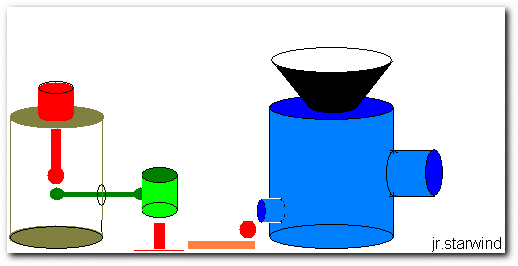|
|
We live at a time when it has become possible to dissect the architecture and operation of nearly any system. However, the nature of the human mind remains essentially unchanged in its preference for concepts that possess attractive simplicity and beauty. Life on earth, for example can be described as a simple system that operates under three simple laws of thermodynamics. Like any system, life requires energy in order to keep going. The ultimate source of virtually all the energy that runs this system is the sun. This radiant energy usually begins its useful progression in photosynthetic units of plants and some species of bacteria.
This takes us to the amazing world of photosynthesis. The simplest form of the process is called photophosphorylation; process that could be summarized with the cartoon below. Place the cursor over the picture to animate it!
 The orange beam represents a photon that upon contact with the reaction center starts a chain of events that culminate in the production of ATP. The photon-activated hammer hits the plank (chlorophyll) causing the red sphere (electrons) to travel to a higher energy state and eventually get transfered to a carrier molecule. The carriers transport the high-energy electrons to the ATP machine. During the process of ATP production the electrons return to their previous lower energy state. Wouldn’t it be nice for photosynthesis to be that simple? We will soon learn it is not. For something as simple as the absorption of a photon is actually a complex multi-component process that elegantly employs the laws of quantum mechanics. Photosynthetic units contain photosynthetic reaction centers, which, under bright light conditions intercepts only about ~1 photon per second. That’s is an insignificant rate, useless for large-scale photosynthesis. This problem is approached with the inclusion of light harvesting systems that intercept and pass the energy of absorbed photons from molecule to molecule until it is re-emitted as fluorescence or absorbed by a photosynthetic reaction center. The inclusion of mechanisms of light absorption and electronic excitation transfer towards the photosynthetic reaction center complicates our previous picture of this process. The end result can be summarized in one sentence: Life’s disconcerting edge of unpredictability is only comparable with the complexity of its components. Indeed, a slightly more complicated picture is needed. One that includes the light harvesting complexes that will be the focus of this paper. The picture below shows a scheme of the photosynthetic apparatus found in the intracytoplasmic membrane of purple bacteria. The wealth of accumulated data makes such system the best characterized of its kind. Details on this photosynthetic mechanism and its dependance on light harvesting systems will be dealt with in the "MACHINERY" section.  |


